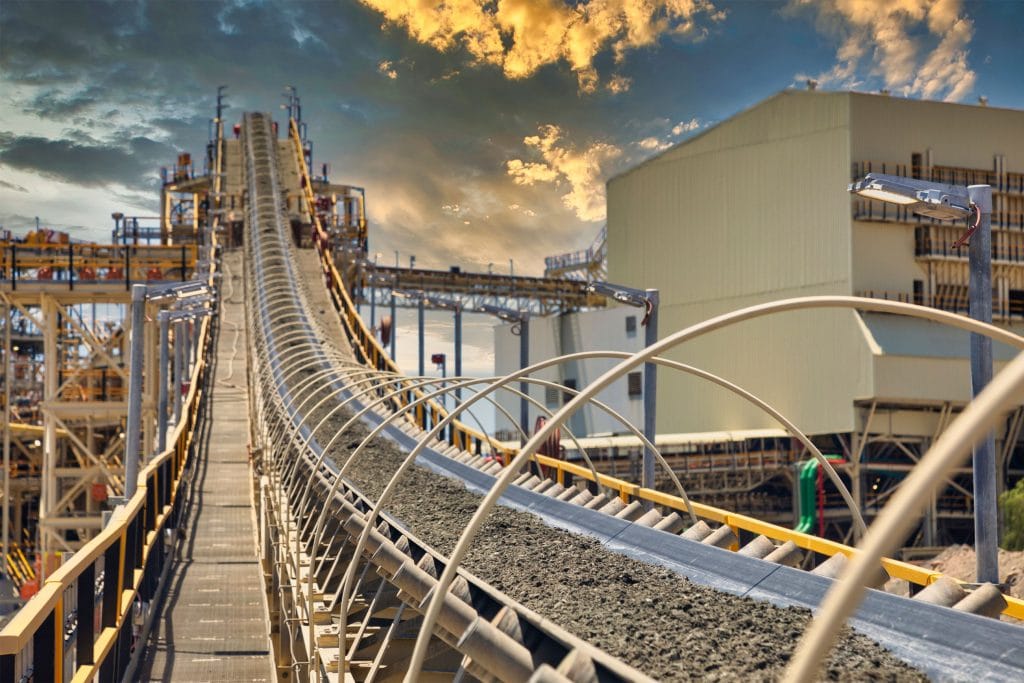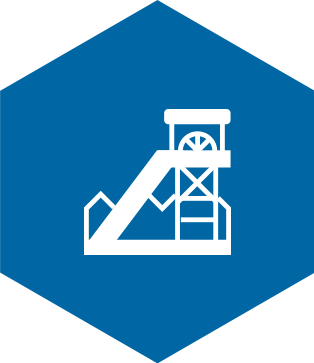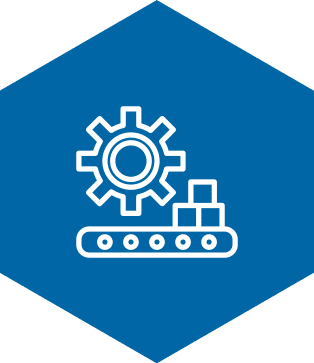
Conveyor systems are essential for demanding mining operations with long runs and uphill hauls. They are effective in adverse environments and for moving heavy and abrasive items and crucial in transporting large amounts of materials. Well-engineered and reliable conveyor systems are efficient, save energy, help manage operation costs, and impose less impact on the environment as they generate less dust and noise.
FAQ Categories
Underground Conveyor Systems – are designed to efficiently and safely bring materials to the surface. Underground conveyor systems help mining operators comply with federal and state regulations concerned with fire, operation safety, hazards to mining operators, working in confined space, dirt management, and dust suppression.
Overland Conveyor Systems – are a cost-effective alternative to trucks for hauling aggregates over long distances. An overland conveyor system can move more material per hour than one truck and spend less energy and labor in the process. Overland conveyor systems have no on-site emissions, do not create roadway dust clouds, and emit less noise than trucks.
Stacker Conveyor Systems – are essential for stockpiling aggregates and are more efficient than wheel loaders or screw conveyors. Stacker conveyors create less dust and damaged aggregates while moving up to 1,200 tons of aggregates per hour.
Portable Transfer Conveyors – are good when working in small areas that are inaccessible by trucks in sand and gravel quarries, aggregate plants and fly ash ponds.
A: Underground conveyor system costs depend on important factors including belt type, vertical rise, material characteristics, structure installation, discharge system, and transport/delivery. The cost of a system with a capacity of 300 tons per hour (tph), a 30-inch-wide belt, and moving at 450 feet per minute over 1,000 feet is in the range of $275,000 to $400,000.
A: Overland conveyor system costs depend on important factors including how much material to move, the material’s nature/property, distance and elevation changes, and belt type. The cost of a system with a capacity of 300 tph, a 30-inch-wide belt, and moving at 450 feet per minute over 1,000 feet is in the range of $250,000 to $350,000.
A: You should consider important factors such as:
Structure installation, whether the conveyor is mounted on the roof or floor of the mine, determines the conveyor design and available work area.
Structure cost is priced per foot and can range from $40 per foot to $150 per foot depending on required belt width, CEMA rating, shell thickness, and structural support requirements.
Alignment-free drive cost includes motors, motor starters, couplings, and reducers and ranges from $110,000 to $125,000.
Belt cost depends on belt width, strength, and the number of plies and can range from $25 per foot to $100 per foot.
A: You should consider the cost of alignment-free drives because these components are usually the most expensive part of conveyor systems. You should also be aware of additional costs such as discharge system cost and conveyor transport cost. Understanding shaft alignment options for your conveyor drive is also critically important to the lifespan, efficiency and safety of your conveyor system.
Discharge systems cost depend on capacity, height, and design characteristics, and can range from $5,000 to $30,000 for more complex designs. The cost of moving underground conveyor systems typically ranges from $5,000 to $10,000.
A: Conveyor systems are better suited for moving mined materials. There are many advantages of using an overland conveyor compared to mining trucks. Conveyor systems are safer, more efficient, can be located anywhere without the need for roads, require less manpower to operate, and are more environmentally friendly than trucking operations.
A: Conveyor systems require minimal maintenance compared to a fleet of trucks. Each mining truck requires seven maintenance and operation workers to run. A modern conveyor belt system requires half of the manpower that is needed to run a fleet of trucks.
Recent advancements in technology allow for the remote monitoring of critical conveyor parts. This further lessens the number of workers required to ensure efficient and safe conveyor operations.
A: You should evaluate the advantages and disadvantages of mining trucks and conveyor systems.
Mining trucks may have lower initial costs; however, their operational costs are fuel and manpower-dependent and typically incur additional costs due to accidents. Mining trucks must wait in line to load up or deposit their materials. They consume fuel and experience wear and tear after they deposit materials and head back to the mine.
Each mining truck requires seven maintenance and operation workers to run. They need maintained roads that are clear of snow and ice during wintertime. Truck accidents could result in spilled fuel and/or spilled load in an environmentally sensitive area.
Conveyor systems are more efficient than an entire fleet of trucks when moving millions of tons of dirt, rock, and gravel over long distances. They need less fuel to operate, can be installed with minimal ground preparation, do not require roadways to operate, and are typically accident-free because they comply with federal and state regulations when installed and operated.
Conveyor systems are the superior choice for moving a large amount of aggregate over long distances in an efficient, safe, and economical manner.
A: You should consider the product that will be transported and the location of the conveyor system when choosing conveyor belts. Specific conveyor belt characteristics to consider include:
A: Conveyor belts have an estimated lifespan of three to ten years when maintained regularly.
A: Conveyor belts need maintenance daily, weekly/monthly, and on an as-needed basis.
Daily maintenance includes checking for belt mistracking, belt slippage, material carry-back, greasing roller bearings, and performing scraper maintenance.
Weekly/monthly checks for belt slippage, mistracking, and material carry-back, and repair or replacement of idlers, rollers, and dust containment systems are recommended. Malfunctioning equipment such as scrapers, idlers, belts, and, rollers should be repaired or replaced as needed.
See our downloadable checklist for conveyor belt inspection and maintenance.
A: To achieve proper tension, belts should be regularly inspected and maintained. The lagging on pulleys, especially on the head drive pulley, should be correctly installed to prevent wear that can result in loss of grip on the belt. Also, bent or damaged pulleys should be replaced to avoid loss of tension and belt slippage.
A: Belt tension problems occur when belts are improperly installed, worn lagging on the head drive pulley have damaged wing or tail pulleys, or belts have slipped due to material overload. Checking for belt slippage is the first step in solving belt tension issues.
A: Causes of carry-back include using poor quality belt cleaning systems, improperly installed scrapers, or using inappropriate or inadequate scrapers. Material carry-back is one of the most common conveyor belt problems.
A: Causes of belt mistracking include misaligned idlers or locked rollers, faulty chute structure skirting, material overload on the belt, and crooked belt splices or worn vulcanized belt splices.
A: Common types of bearings include:
Pillow block bearings include a mounting that is secured to a solid base. They are fabricated to be relatively corrosion resistant and work best with high loads or high speeds.
Taper-lock and flange bearings support inner tapered rings that are fitted into a tapered sleeve bearing and are designed to work with large vertical and horizontal forces, such as wheels and vehicle operations.
Two and four-bold bearings are designed to create a solid base to bear larger loads and longer shafts.
A: Conveyor backstops protect inclined conveyors from gravity, notably when it comes to accelerated reverse runways. Important factors to consider when choosing the appropriate conveyor backstop include backstop speed (high or low speed), sizing, capacity, and ease of installation.
A: A wide range of conveyor motors include:
Each motor offers speed control in single or three-phase options and comes in stainless steel, aluminum, or cast-iron construction. Our team can help you find the right type of motor that would work best for your conveyor.
A: The main role of the reducer/gearbox is to control the speed of the conveyor belt. Factors to consider when selecting the right one include the size of the load, the specific type of load, the size and type of the gearbox (considering RPM and horsepower), ambient temperature, frequency of conveyor use, and the environment in which the conveyor will be operating.
A: A shaft mount reducer is a helical gear that is enclosed on a conveyor line, transferring torque to the rest of the line.
Factors to consider when selecting the right shaft mount reducer include the amount of horsepower, speed adjustment, brand and durability, types of warranties, and availability of rebuild kits.
Due to the importance and complexity of this component, you should choose suppliers and manufacturers that are knowledgeable, helpful, and reputable. Our team can help you find the right shaft mount reducer that would work best for your conveyor.
A: Fluid couplings are hydrodynamic devices that transmit rotating mechanical energy between drive shafts, protecting the belts, motors, and drives of the conveyor system. Factors to consider when selecting the right fluid coupling include the power level and type of coupling for your operation (constant fill or fill controlled), total system inertia, and thermal performance.
Simulation software can help you analyze startup behavior and run various virtual trials with different types of loads and conditions, allowing you to make an educated decision on the fluid coupling for your platform.
A: Diversely purposed pulleys are available for conveyor systems including:
Our team can explain in detail and help you find the type of pulley that would work best for your conveyor.
A: The advantages of choosing a used or rebuilt motor include saving money, having the option to further customize the motor, and a potentially faster turn-around because motors are usually in stock and ready to sell. Our team can evaluate your conveyor system and provide detailed recommendations on used or rebuilt motor options for your platform.
A: A heavy-duty belt cleaning system or scraper is an essential piece of a conveyor. You should choose scraper systems that are efficient, easy to clean, work with less material loss, keep dirt from getting inside the conveyor system, and reduce dust.
A: If you have too much dust kicking up, the transfer chutes you are using might be part of the problem.
You can employ skirts, hood and spoon, water sprays, and complete transfer chute designs to suppress dust. Heavy-duty rubber skirts fill the gap between the bottom of the discharge chute and the lower conveyor. Hoods direct the material stream downwards at the end of the upper conveyor where the material waterfalls, and spoons that curve the material flow. Water sprays remove particulates from the air and keep them on the material being conveyed.
Finally, you can incorporate sophisticated software and special transfer chute designs that account for material characteristics, flow rates, and impact angles to manage material stream while minimizing impacts and preventing blockages.
Click here for more information on dust containment systems.
A: West River offers our customers the flexibility to participate in the production of their customized equipment. Accuracy is ensured down to the last bolt. We use carefully selected, industry-leading materials to produce a more rigid, mine-duty frame that does not distort during installation or use. The use of heavier steel results in products that surpass the basic requirements of the most demanding bulk material handling operations.
A: Factors to consider when designing a conveyor include material transport requirements, conveyor environment, loading and unloading concerns, budget, and project timeline.
A: Rigid rail, catenary, and wire rope conveyor structure all serve different purposes. Factors to consider when choosing conveyor structure include CEMA rating, conveyor system capacity, speed, spacing of idlers, and structure material type.
A: Mining conveyors require heavy-duty drive systems such as a base mount drive configuration requiring precision measurement, and alignment-free drive configurations that rely on shafts to control alignment.
A base mount drive configuration consists of a motor and reducer mounted on a solid base. In an alignment-free drive configuration, the motor is mounted to the reducer and the motor/reducer assembly is mounted directly to the pulley shaft.
For almost 40 years, West River Conveyors has provided quality, affordable, top-notch conveyor systems and mining equipment. We provide complete conveyor systems for diverse mining industries including coal, sand and gravel, trona, salt, and potash. Our products include industry-leading brand parts and have been thoroughly tested in the most demanding bulk-mining operations.
West River is committed to building quality products and complete customer satisfaction is our goal. We are ready to assist you with any of your conveyor system questions and emphasize the importance regular maintenance plays in extending the lifespan and performance of your system.

Cost-effective solutions for hauling aggregates like sand and gravel over long distances.
LEARN MORE
Improve mining operations with custom conveyors that are tested for safety and reliability.
LEARN MORE
An online inventory stocked with gearboxes, fluid couplings and other parts ready to be shipped.
LEARN MORE
Avoid unplanned downtime and injuries that can arise from worn out conveyor belts.
LEARN MOREEfficient material handling is crucial for mining productivity, safety, and cost-effectiveness. Whether you’re upgrading an existing conveyor system or adding a new one, careful planning and execution are essential. This read more »
As mining operations grow, so does the need for efficient material handling solutions. Expanding production requires systems that can keep up with increased demand while maintaining reliability, safety, and cost-effectiveness. read more »
Imagine your mining operation grinding to a halt because of one overlooked component. It happens more often than you'd think, and the culprit is frequently the conveyor belt—the unsung hero read more »